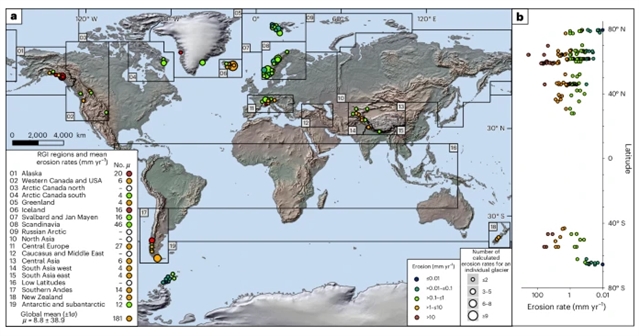
近日,加拿大达尔豪斯大学John C. Gosse团队研究了全球冰川侵蚀速率的驱动因素。2025年8月7日出版的《自然—地球科学》杂志发表了这项成果。
冰川侵蚀应被量化,以更好地约束众多的地貌和造山过程;然而,冰川侵蚀的精确模型受到数据稀疏的限制。
研究组将机器学习工具用于开发基于181个当代冰川衍生侵蚀率的全球尺度综合的冰川侵蚀和冰川学、地形气候和地质变量的方程。结果揭示了激流型、海洋型和陆地型冰川环境的特定环境侵蚀速率方程。研究组证明,在任何环境中,冰川速度都不是冰川侵蚀最重要的统计预测因子。相反,如果将速度与额外的冰川学、地形气候和地质变量一起考虑,其中降水、冰川海拔、长度、纬度和下面的地质因素表现出最主要的影响,则可以改进对冰川侵蚀的预测。
利用这些方程,研究组估计了85%的当代冰川的侵蚀速率,其中99%的侵蚀速率在0.02 - 2.68毫米/年之间。他们的结果表明,需要调整该团队预测或后推冰川侵蚀速率的方式,并强调它们不仅对冰川滑动速度变化敏感,而且对其他冰川学、地形气候和地质影响也敏感。
附:英文原文
Title: Drivers of global glacial erosion rates
Author: Norris, Sophie L., Gosse, John C., Millan, Romain, Mouginot, Jeremie, Rabatel, Antoine, Morlighem, Mathieu, Bolton, Matthew S. M., Alley, Richard B.
Issue&Volume: 2025-08-07
Abstract: Glacial erosion must be quantified to better constrain numerous geomorphic and orogenic processes; however, accurate models of glacial erosion have been limited by sparse data. Here we use machine learning tools to develop equations that integrate glacial erosion and glaciological, topoclimatic and geological variables based on a global-scale synthesis of 181 contemporary glacier-derived erosion rates. The results reveal environment-specific erosion rate equations for surge-type, marine- and land-terminating glacial settings. We demonstrate that glacial velocity is not the most statistically important predictor of glacial erosion in any environment. Instead, an improved prediction of glacial erosion is attained when velocity is considered with additional glaciological, topoclimatic and geological variables, with the most dominant influences exhibited by precipitation, glacial elevation, length, latitude and the underlying geology. Using these equations, we estimate erosion rates for 85% of contemporary glaciers, with 99% eroding between 0.02 and 2.68mmyr1. Our results suggest a need to adjust how we predict or hindcast glacial erosion rates and highlight their sensitivity not only to changes in glacial sliding velocity but also to additional glaciological, topoclimatic and geological influences.
DOI: 10.1038/s41561-025-01747-8
Source: https://www.nature.com/articles/s41561-025-01747-8
